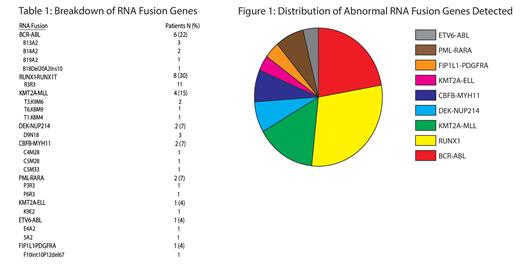Background
Oncogenic fusion genes play an instrumental role in the pathogenesis of haematological malignancies and the identification of these genes is crucial for diagnosis, risk stratification and treatment decisions. Conventional diagnostic methods such as karyotyping and fluorescence in situ hybridization (FISH) are the current standard of care but are limited in the sensitivity and availability of different FISH probes for detection of fusion genes. In our institution, we have routinely integrated a targeted next-generation sequencing (NGS) panel in our diagnostic workflow for patients with suspected myeloid malignancies. Here we aim to review the cases with RNA fusion genes detected via NGS and compare these results with that of conventional diagnostic methods.
Methods
We analysed bone marrow samples from patients with suspected myeloid malignancies at the time of diagnosis in Singapore General Hospital (SGH). Extracted genomic DNA and RNA were amplified, and library preparation was performed with the Oncomine TM Myeloid Research assay (Thermo Fisher Scientific) to interrogate 40 DNA genes and 29 fusion driver genes. NGS libraries were sequenced on the Ion GeneStudio S5 System (Thermo Fisher Scientific) and analyzed using in-house bioinformatics pipelines and the Ion Reporter software. Limit of detection was determined as 3% allele frequency for DNA variants and 10 -2 for RNA fusions. RNA fusions detected by the NGS panel were consolidated and compared with cytogenetics (karyotyping and FISH) results.
Results
A total of 436 samples from adult patients with suspected myeloid malignancies were received for NGS testing from October 2021 to March 2023 in SGH, the largest tertiary hospital in Singapore. 306 had paired cytogenetics and NGS testing performed. 27 of the 306 cases (9%) had RNA fusions detected by NGS as summarized in Table 1 and Figure 1; their disease subgroups comprised of 16 acute myeloid leukaemia (AML), 5 chronic myeloid leukaemia (CML), 3 BCR-ABL1-negative myeloproliferative neoplasm (MPN), 2 acute promyelocytic leukaemia (APL) and 1 myelodysplastic syndrome (MDS).
Eight AML cases had RUNX1-RUNX1T1.R3R3 fusions, with 6/8 (75%) harbouring additional DNA single nucleotide variants or indel mutations. Two AML cases had CBFB-MYH11 fusions, with 1 associated with KIT D419 deletion, and the other with U2AF1, NF1, and ASXL1 mutations. We also identified 2 adult AML cases (aged 49 and 65 years respectively) with DEK-NUP214.D9N18 fusions, both of which had associated FLT3-ITD mutations. There were 5 cases with KMT2A fusions, with a variety of partners including MLLT3.K9M6 (n=2), ELL.K9E2 (n=1), MLLT1.K8M4 (n=1), and MLLT6.K8M9 (n=1). Two patients with APL had PML-RARA detected for different variants: P3R3 and P6R3. Amongst the 8 MPN cases, 5 had BCR-ABL1 fusions consistent with diagnosis of CML. There was 1 case of MPN-Eo with FLP1L1-PDGFRA fusion, and the remaining 2 with ETV6-ABL1 and KMT2A-ELL.K9E2 rare fusions.
The detected RNA fusions had clinical impact in establishing diagnosis (93%), prognosis (96%), and guidance of treatment decisions (89%). Out of the 27 cases with RNA fusions detected by NGS, 23 (85%) had concordant karyotype and FISH results. Four RNA fusions, namely KMT2A-ELL, CBFB-MYH11, FIP1L1-PDGFRA and ETV6-ABL1, were not detected by karyotyping or conventional FISH probes performed in our institution. It likely reflects the sensitivity of the NGS panel in detecting RNA fusions in cases of cryptic translocations.
Conclusion
We have demonstrated that NGS has a high sensitivity for identification of RNA fusion genes, is complementary to conventional cytogenetics testing, and has vast clinical impact in terms of diagnosis, prognostication and clinical management. We advocate for the integration of NGS with DNA and RNA sequencing into routine investigation of suspected myeloid malignancies for a more precise and comprehensive diagnostic approach.
Disclosures
Chuah:Korea Otsuka Pharmaceutical: Honoraria; Bristol Myers Squibb: Honoraria, Research Funding; Novartis: Honoraria, Research Funding; Pfizer: Other: Travel, Research Funding.


This feature is available to Subscribers Only
Sign In or Create an Account Close Modal